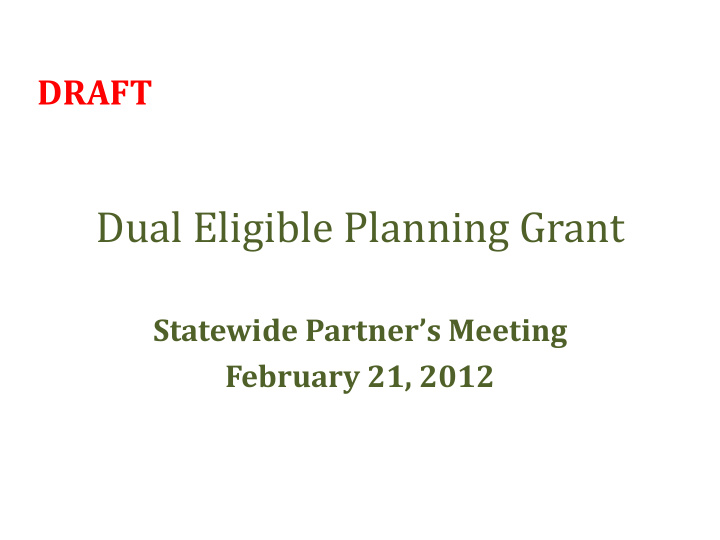



DRAFT Dual Eligible Planning Grant Statewide Partner’s Meeting February 21, 2012
Demonstration Design DRAFT Fully Dual Eligible Adults (>21 yrs.) = 222,151 • Statewide, all 100 Counties • Managed fee for service model building on current medical home • infrastructure
DUAL ELIGIBLE STRATEGIC FRAMEWORK DRAFT Flexible Use of Public Funds for Supports Provider Function Based Capacity Resource Incentives Allocation Beneficiary Use of Goals Independent Actionable Data Assessment of Need Beneficiary Centered Medical Homes Natural Supports and Community Resources
Beneficiary Goals DRAFT Primary Care, Preventive Care & Pharmacy Assistance Independent Living Skills/ Palliative Care Habilitation Quality of Life & Self- Management Support Recovery & Daily Living Behavioral Health Supports Support Acute Care & Rehabilitation
Natural Supports and Community Resources DRAFT Dual Eligible Model Natural Supports and Enhancements Community Resources • Engage beneficiaries & * Family community stakeholders to guide model * Faith-Based Supports • Improve access to training and * Friends education for beneficiaries, * Community and family caregivers & providers Social Supports • Develop broader community dialogue about advance * Accountable Care directives & palliative care Organizations options • Support for evidence- * Emerging Initiatives based best practice programs
Enhanced Quality DRAFT Dual Model Goals Dual Model Strategies • • Increased beneficiary Quality indicators for satisfaction medical homes, all settings Medicare 646: • Improved health • Quality measures • outcomes • Provider tiers with Lessons learned explicit capacity and • Shared savings performance standards
Beneficiary Centered Medical Home DRAFT Dual Eligible Model Beneficiary Centered Enhancements Medical Home • Medical homes for duals in all * Primary Care Physicians settings * Preventive care • Medicare 646 demonstration * Screening and Assessment experience * Pharmacy Management • Explicit expectations for provider quality improvements * Self Management Education • Greater provider capacity via * Team Based Care Management incentives- ex: treatment in place * Evidence Based Practices • 24/7 call response capacity * Clinical Information Systems • New communication protocols, tools • Information sharing resources * Behavioral Health Integration enhanced * Transition Supports • Palliative Care Capacity * Risk Stratification
Information Access DRAFT HIE ADRC Assessment Beneficiary Data Information E- Prescribing ED/Hospital
FUNCTIONAL NEEDS MATRIX PHYSICAL HEALTH MENTAL HEALTH/COGNITIVE/EMOTIONAL IMPAIRMENT IMPAIRMENT QUADRANT 1 QUADRANT II INTACT MILD MODERATE SEVERE INTACT MILD MODERATE REHAB MED. CONDITIONS+/- OPPO. BEHAVIORS CLINICALLY COMPLEX SPECIALIZED CARE QUADRANT III QUADRANT IV
Home and Community Based Services DRAFT Dual Eligible Model Home and Community Enhancements Based Services * Current Medicaid waiver • Flexible use of public programs and other in home funds care services * Respite and other caregiver • Coordinate with support developing Community * PACE Resource Connections such as ADRCs * Money Follows the Person, other transition programs • Grow peer support * Adult Day programs capacity and recovery oriented behavioral * Rural Primary Care Access health supports * Other HCB programs • Maximize use of * Assistive devices technology
Medical Home for Nursing Home Residents DRAFT Tier 5 Tier 4 Tier 5 Standards ( +1,2,3,4) * 24/7 Call system with consultation * Embedded MD serves as Medical Director Tier 3 * First page of chart to display patient Tier 4 Standards ( +1,2,3) wishes *As appropriate, palliative care goals- * 24/7 Call system with trained LTC prominent and current with evidence providers of discussion with patient/family/ * Regular on-site schedule 2-3 days per week Tier 3 (+1,2) designated caregiver * Embedded MD/NP Tier 2 Standards * Periodic review of med list; e- * Physician presence on site fixed * Patient wishes/care goals evident in days/times of the week (1-2 days) prescribing, e-reconciliation medical records * Facility encourages a reduced # of * Medication review with risk-benefit physicians attending residents assessment * Advance directives (reviewed every Tier 2 Standards ( +1) * Root cause analysis of unplanned ED/ 6 months) Tier 1 hospital admissions * All transitions have clear * Medication reconciliation (Med. * Clearly established performance standards communication prior to leaving Rec.) by CCNC * Enhanced oral health care facility (transition policy in place * Explicit attention to with transfer form, name and psychotropic and anticoagulant/ number of single contact) anti-platelet drugs Tier 1 Standards * Oral health care for residents * Attending physicians review and act on med. rec. recommendations * Medication review Legal guardian/DMPA * Licensed Medical Director and identification and acquisition individual attending physicians policy in place *Attending physicians for residents * Standard access to provider (intermittent/week) portal information/reports * Advanced directives in place * Access to registered dietitian
Medical Home for Adult Care Home Residents DRAFT Tier 3 Tier 2 * Treatment in Place * Protocols in place and regularly updated to identify and respond to early warning signs to avoid crises * Advance directives for residents with Tier 1 behavior health conditions * Prepared for family/resident palliative care and hospice care plan * 24/7 call support to reduce unnecessary implementation emergency department visits/ambulance * E-prescribing calls * Facility has established relationship with Other incentives for achieving Tier 3: 24/7 call practice * All residents enrolled in medical * Potential regulatory relief * Electronic resident assessment records homes with their PCP ** Reductions in unnecessary hospital accessible to PCPs * Patient care goals documented admissions result in potential shared * Communication protocols for hospital and * Established relationship with LME for savings ED transitions residents with behavioral health needs * Facility encourages residents toward fewer * Resident medication review & PCPs reconciliation, care management, evidence-based health, wellness and self-management education facilitated by Network * Electronic resident assessment * Advance directives discussions documented in resident records
Potential Shared Savings DRAFT Strategic Priorities will be based on Medicare data analysis • Multiple elements for anticipated savings, most notable areas, • – Medication therapy management – 24/7 call coverage to reduce unnecessary emergency department use – Increase access to primary care supports to reduce avoidable hospital admissions
Dualfuture@n3cn.org http://www.communitycarenc.org/emerging- initiatives/dual-eligible-initiative/
Recommend
More recommend